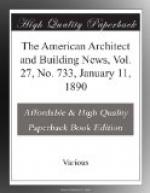The two Palaces of the Fine Arts and the Liberal Arts are of equal dimensions and similar aspect. They cover an area of 21,000 square metres. They are composed of a large central nave, measuring 209.31 metres in length by a width of fifty-three metres and one-half. The nave is surrounded with galleries on the lower floor and first story. On the garden under the porticos are restaurants. Each of these palaces is connected with the Industrial section of the foreign countries by a large vestibule thirty metres wide by 115 in length, one of which, that of the Fine Arts, contains the exhibition of sculpture, and the other contains a large part of the musical instruments. These two palaces are entirely of iron, terra-cotta and ceramic work. The entrance is executed by a large porch of three arches, and the wings on either side are pierced by wide bays. Each is crowned with a dome fifty-five metres high and thirty-two in width. These two palaces are striking examples of the richness which can be introduced in a moment by the artistic employment of terra-cotta and ceramic work, especially when the ceramic artists bear such names as Mueller, Loebnitz and Parvillee, to say nothing of MM. Breult, Boulanger and Mortreux, whose work we met in the ceramic division, or which we shall meet in our walks through the foreign pavilions. With M. Mueller, who has given his name to a kind of brick covered with enamel on one of its faces, ceramic work becomes a portion of the very fabric itself as well as of its ornamentation. This principle applied with rare talent to the covering of the two domes of the palaces has given a very curious and interesting result. This covering is composed of enamelled tiles of more than 600 varieties which are not superposed one upon another, but butt together side by side, and form a mosaic rather than a covering of tiles. Each dome contains about 50,000 pieces arranged in ninety rows and twelve divisions. The general tone is blue. The principal ornamental motive consists of a cartouche which bears in the centre two large letters “R.F.” in gold. The cartouche stands out on a background of cream-white, bordered with a meander. The effect is very brilliant and chatoyant. At the base of each dome twenty-four vases in pottery, three metres high, are arranged on the consoles of the attic which supports the roof, and in which are pierced bull’s-eyes decorated in tones of blue and natural terra-cotta. The domes of the pavilions at the angle of the palace on the side of the Seine are in the same way covered with enamelled porcelain tiles. This is a new product invented by M. Parvillee and has a great decorative richness. Above each bay of the two palaces is repeated a terra-cotta frieze two metres high, which bears children holding cartouches and standing out from a golden background. Pillars between the bays are encased in terra-cotta fluted panels with interlacements of laurel and oak leaves. The ironwork of these pillars is exposed and encloses the terra-cotta work like a Spanish net, with very original effect and very interesting constructive frankness. Finally, the balustrade crowning each palace is also of terra-cotta, and is formed of small pilasters and between them is repeated a motif of bucklers bearing lions’ heads. The balustrade is composed of 7,500 pieces and weighs 450,000 kilogrammes, and covers a space of 2,000 square metres.




